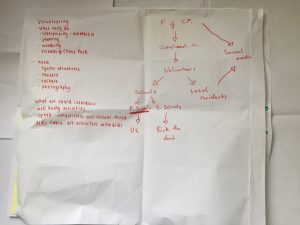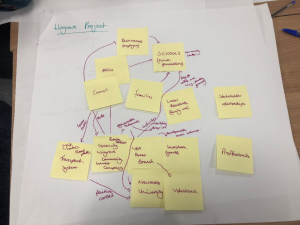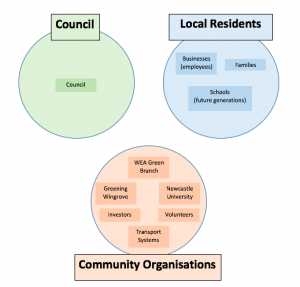Log week 3
Hello, this week we decided upon our user research methods. We believe the best method for us would be to participate in detailed (structured) interviews with stakeholders and the general public, and also to take general observations of the areas usage. Within the seminar we came up with some brief questions, following this we met as a group to expand upon them more.
Planned site visit
This week we contacted Ali to try to organise a meeting with her, Mark (computer, tech side of the project) and Julie (environmental/health side of the project) although Julie wasn’t able to make the dates suggested, so we have agreed to try to meet up next week with them where we will be able to ask them more detailed questions about the project. As we cannot interview them this week we have decided to make a site visit instead to Heaton Road, to try to interview some of the locals and the stakeholders. We realise that we need different types of interviews for each set of people, some needing to more open and others more specific and closed to only certain groups of people who would know the answers or have experience with the questions asked. We would like to talk to a few of the people below, although we have been warned due to local elections to not focus on them too much. These would be users such as:
- Residents (both alongside Heaton Road and nearby neighborhoods)
- Cyclists
- Stakeholders
Examples of our “open” to all questions – resident, general public etc.
- What is your main usage for Heaton Road ?
- What are your usual methods of transport when on this road?
- Do you find parking spaces easy to find and are there a good amount of them?
- Would you find travelling along Heaton Road a positive experience, and why is this?
- What would you change, if anything, about Heaton Road if you could?
Examples of our “closed” for certain people questions – Mark, Julie, Ali, Space for Heaton etc.
- What is your main usage for Heaton Road?
- What are your usual methods of transport when on this road?
- How do you feel about parking along Heaton road?
- Do you find spaces easy to find and are there a good amount of them?
- What would you change, if anything, about Heaton Road if you could?
- Do you believe the changes would be beneficial for the area?
- What incentives would you think would lead people to want the changes made?
- What are the main reasons you believe people are against?
From these questions we hope to gain a greater insight into how people feel about the project and its outcomes, hopefully helping us to understand our project end goal a bit more, and the process in which we will develop our prototype to which will help us achieve this goal. We realise the reasoning behind why our research activities should be individual as to be the fact that many people should be be approached differently and we aim to get a less biased view of these things, alongside this the elections that Ali told us about play a large role in us needing to keep open questions as we wouldn’t want locals views to be changed due to our influence.
Additional Research
Streets for people ; Heaton and Ouseburn 1
Streets for people : Heaton and Ouseburn 2
After researching further into the Streets for People which is a local research method that has already been collected by the local groups, we found these two links which lead to posters including information on pedestrians, cyclists and drivers. This information showed us that pedestrians held the highest percentage of travel (42%) and cyclists came second with (34%) driving came in with the lowest percentage out of the three options (13%). We also took note that 51% of the people wanted a segregated cycling route, proving to us that this was a slightly more prefered option and our project is more favoured.


 We began by naming the main stakeholders such as families, local residents, community organisations and WEA Green Branch, then branching off from these, connecting in other local groups. We discovered that the WEA Green Branch would have a link with the Greening Wingrove Community Interest Company and also with investors (who provide grants for events and developments). Volunteers and students from Newcastle University were also interlinked within this group as they would help provide support for many of the events done by WEA and Greening Wingrove. Another connection was found between the WEA and schools in the area, as education centres are a central hub for community connection. We felt having schools as one of the key stakeholders would help disburse information more effectively. Lastly, from schools there comes a link with families, the police, businesses and the council, therefore creating a bridge between the different interest groups within the area.
We began by naming the main stakeholders such as families, local residents, community organisations and WEA Green Branch, then branching off from these, connecting in other local groups. We discovered that the WEA Green Branch would have a link with the Greening Wingrove Community Interest Company and also with investors (who provide grants for events and developments). Volunteers and students from Newcastle University were also interlinked within this group as they would help provide support for many of the events done by WEA and Greening Wingrove. Another connection was found between the WEA and schools in the area, as education centres are a central hub for community connection. We felt having schools as one of the key stakeholders would help disburse information more effectively. Lastly, from schools there comes a link with families, the police, businesses and the council, therefore creating a bridge between the different interest groups within the area.